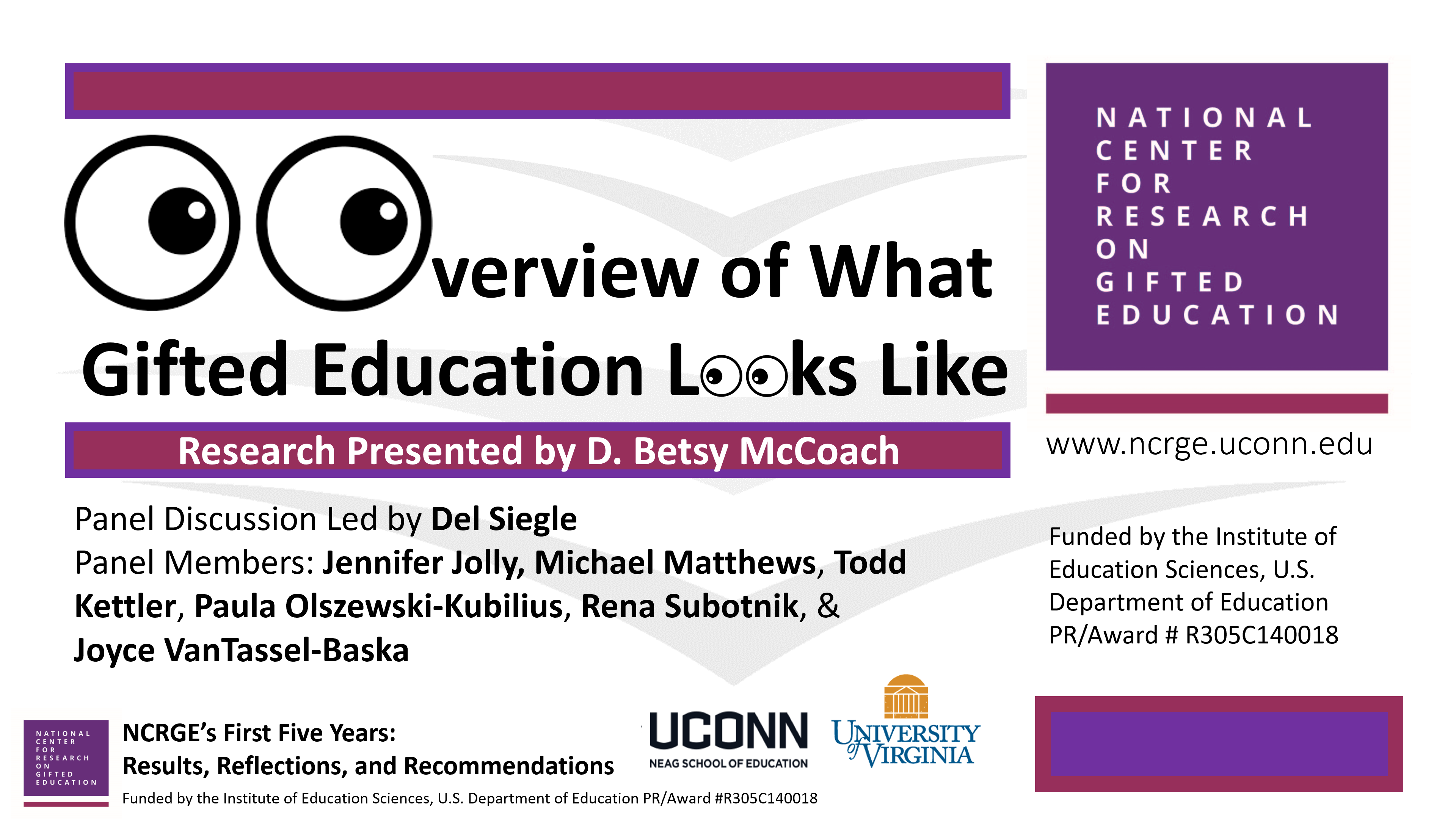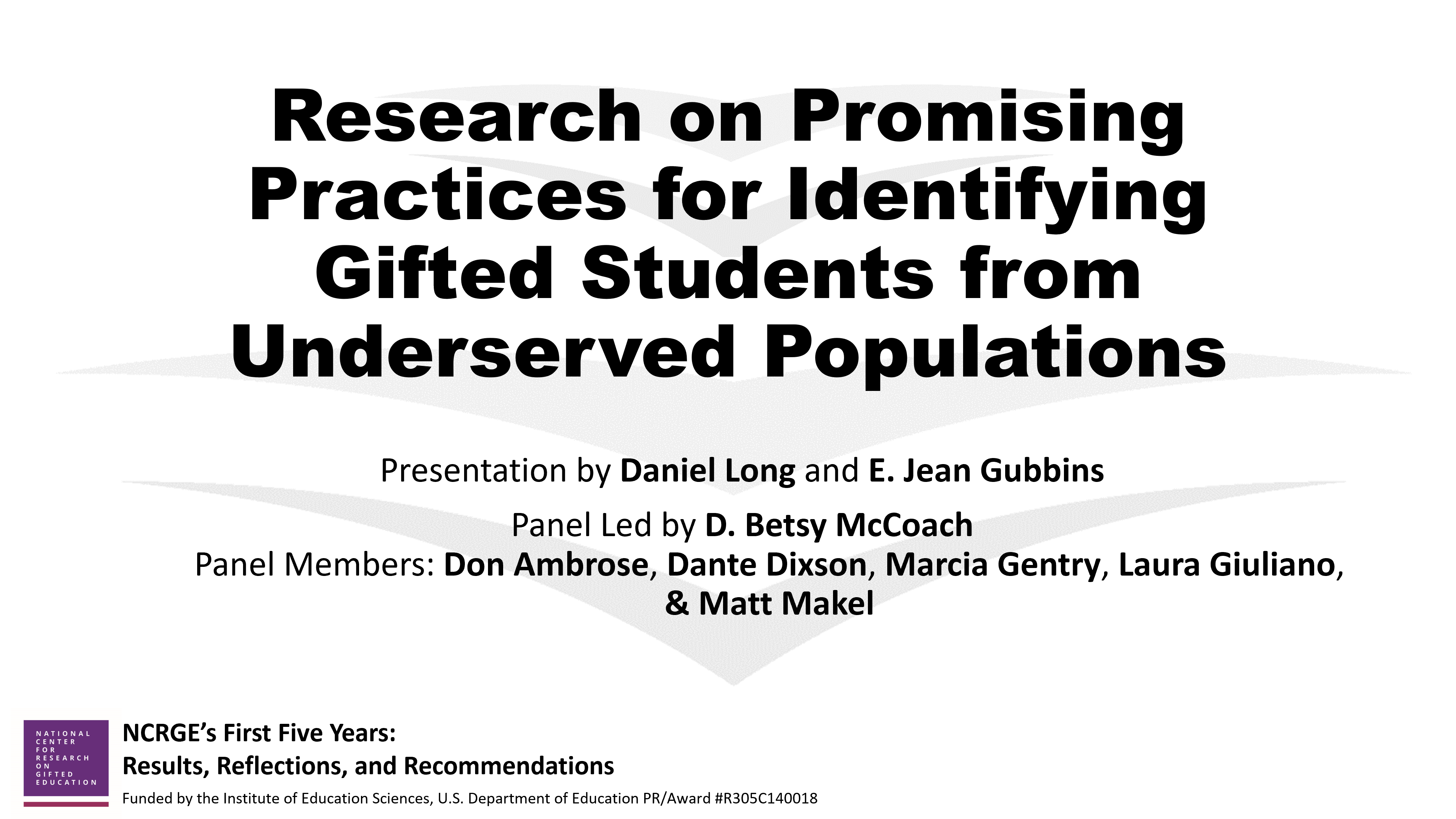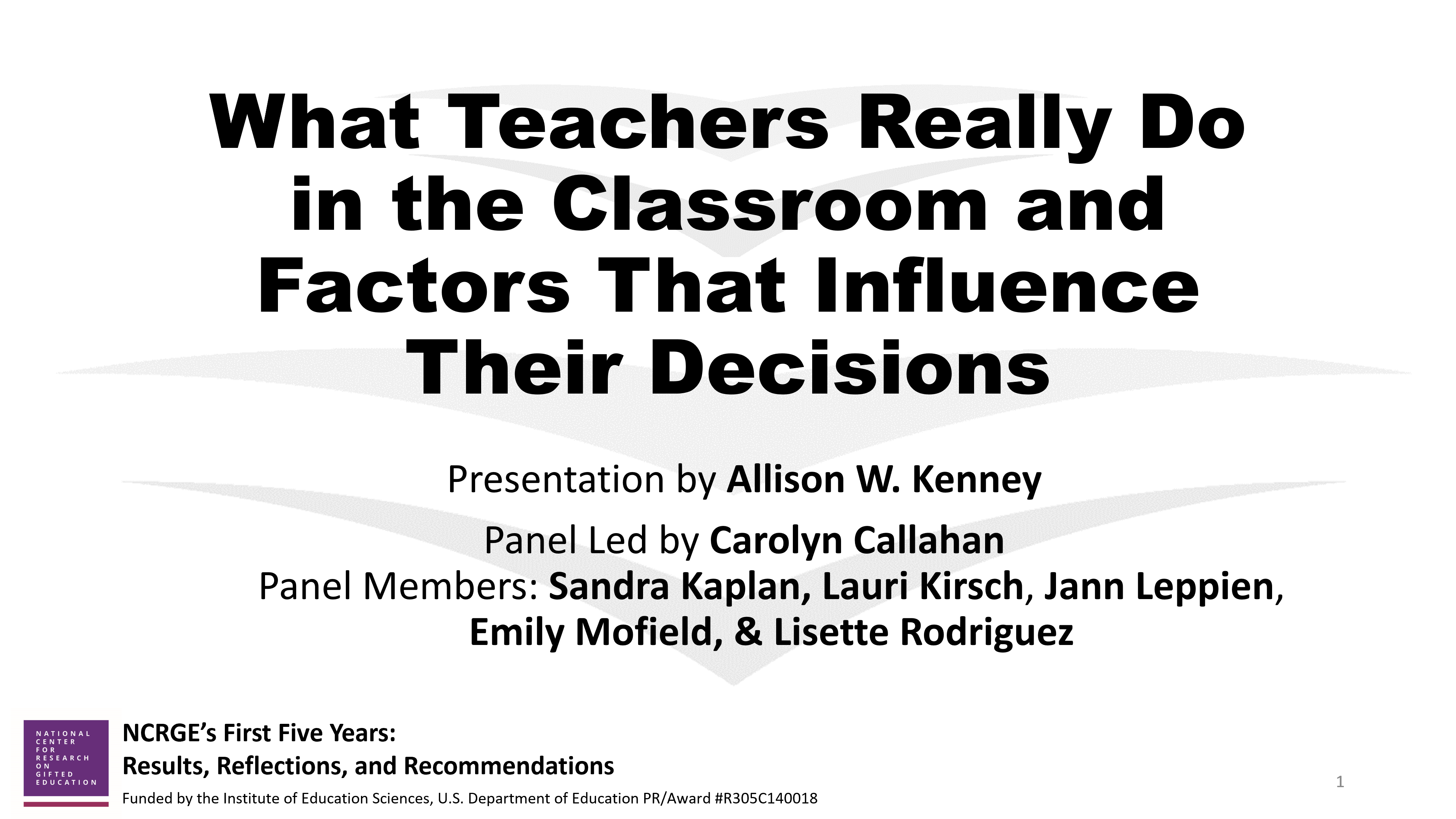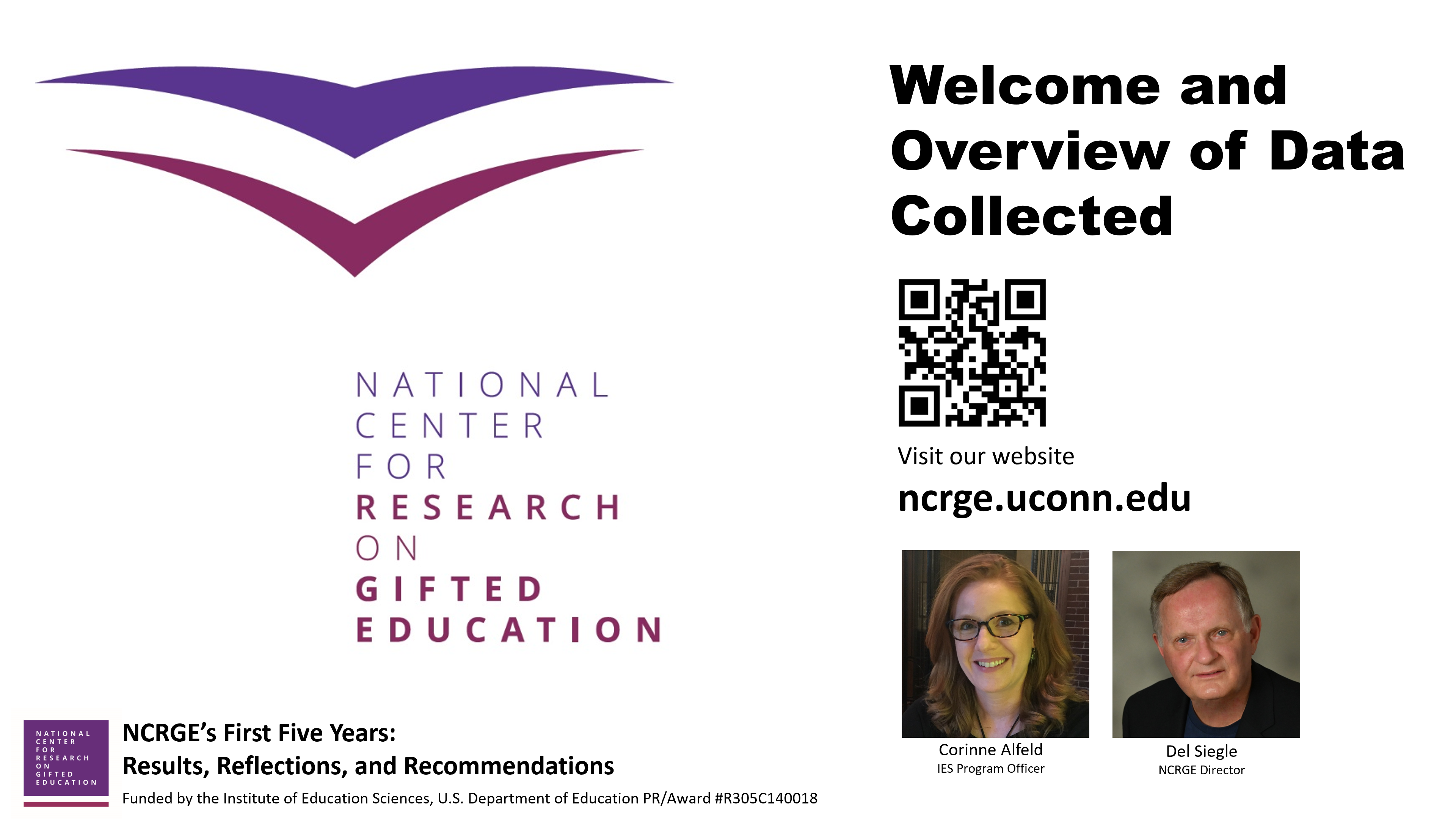2014-2020 — Systematic Exploration of Gifted Programming
Seeking Promising Practices in Three States
NCRGE research encompassed a 3-year Phase 1 project followed by a 2-year Phase 2 project, and a one-year no cost extension. Our Phase 1 work examined the extent of gifted programming using school and district survey data we collected across three states with mandates to identify and serve gifted students. We examined student participation and achievement in those three states using individual student data provided to us by the state departments. We surveyed the schools and districts in the three states to determine current school and district practices in identification and service delivery. We also examined gifted district plans (n=293) on 133 variables from two states. We received complete student achievement and demographic data for an entire cohort of elementary school students over a 3-year time span (3rd-4th-5th grades; n = 362,254) from the three states. We merged the student data with the school (n= 2,419; 45-68% response with 80% response for Title 1 schools) and district (n=332; 78-90% response) survey data and the district plan data to examine practices associated with increased identification of underserved populations and practices associated with increased achievement. We visited select schools (n=23 schools across 16 districts) to further our understanding of these practices (n=202 interviews). We also conducted an additional study of schools that successfully identified gifted EL students. In that work, we visited an additional 16 schools.
Key Findings from Phase 1
- Gifted services are not equally distributed across schools within districts. The variance between schools in a district is greater than the variance across districts in a state.
- Underserved populations are not being identified at the same rates as non-underserved students even after controlling for student achievement. EL, free or reduced lunch, and Latinx and Black students are less likely to be identified as gifted even if they have the same reading and mathematics achievement as students not from these groups.
- Very few districts reassess students once they have been identified.
- Very few districts offer programs to identify and recruit potentially gifted students. Pre-identification talent development programs are rare.
- There is extensive use of cognitive tests to identify gifted students.
- Most districts identify gifted students in 3rd grade.
- Third grade academic achievement is directly related to identification gaps in identification of gifted students.
- Practices such as universal screening and nonverbal tests do not appear to be panaceas for removing the identification gap.
- Universal screening with modification shows promise at reducing under-identification of underserved populations.
- Most schools use pull-out classes for gifted instruction.
- Gifted programs seldom focus on core curriculum such as math and reading. Gifted programs have a greater focus on critical thinking and creative thinking than reading/language arts and mathematics.
- Gifted students start ahead in reading and mathematics achievement at 3rd grade but don’t grow any faster than other groups by 5th grade. In some cases, gifted students show slower growth during this period than non-identified gifted students.
- EL reclassification is linked to gifted identification. Each year a student has EL services, he or she is 30% less likely to be identified as gifted. EL students exit EL programs faster in schools with greater percentages of gifted students.
- When school personnel serve as talent scouts and interact with each other they are more effective in identifying gifted learners from underserved groups.
- There is a high level of agreement between district and teacher reports of practice and curriculum for gifted students.
We created an app that will allow you to plot the growth patterns of different student populations in the three states we studied.
Key Findings from Phase 2
Our Phase 2 work examined the effect of attending dedicated gifted classes in core content areas on students’ academic achievement in reading/ELA and mathematics in a large, ethnically, economically, and linguistically diverse urban school district. We received students records for two cohorts of 4th and 5th grade students (n=26,515 and n=26,838). Our analyses compared the reading/ELA and math achievement of gifted students in three different settings: schools offering a full-time gifted-only program with gifted classes in all subject areas, schools offering a part-time gifted-only program with gifted classes in mathematics, and schools offering a part-time gifted-only program with gifted classes in reading/ELA. In addition, we conducted a qualitative study to better understand how the gifted classes differed from the general education classes. We visited 15 schools that offered different combinations of the three service options. In each school, we observed instruction in both gifted and general education classrooms, and we interviewed teachers/staff (n=94) and principals (n=16).
- Merely grouping gifted students together in classes is unlikely to result in increased academic achievement.
- Differentiated work for advanced students is often an afterthought or a way to occupy them while teachers work with students who needed remediation.
- Removing gifted students from general education classes appears not to have a detrimental effect on the high achieving non-gifted students who remain in general education classes.
- District pacing guides rule the day. Teachers are reluctant to venture from the pacing guide to implement instructional and curriculum differentiation based on modifying content, process, products, and learning environment to meet identified gifted students’ advanced academic needs.
- School principals shape the climate in which teachers feel empowered over or limited in options for managing their instructional time in the world of pacing guide dominance.
- Teachers who perceive a sense of autonomy report using a wider variation of practices to enact their autonomy as it relates to pacing, instruction, content, and materials/resources.
NCRGE’s First Five Years: Results, Reflections, and Recommendations
Conference Recordings and Slides
The National Center for Research on Gifted Education (NCRGE - 2014-2020) held a free virtual conference on Friday, March 26, 2021, titled "NCRGE's First Five Years: Results, Reflections, and Recommendations." The virtual conference included three short presentations by NCRGE researchers followed by reflections and recommendation for practice and future research from panelists.
Presentation: Welcome and Overview of Data Collected
Presentation: Overview of What Gifted Education Looks Like
Slides: Overview of What Gifted Education Looks Like

Presentation: Research on Promising Practices for Identifying Gifted Students from Underserved Populations
Slides: Research on Promising Practices for Identifying Gifted Students from Underserved Populations

Presentation: What Teachers Really Do in the Classroom and Factors That Influence Their Decisions
Slides: What Teachers Really Do in the Classroom and Factors That Influence Their Decisions

What Teachers Really Do in the Classroom and Factors That Influence Their Decisions 3_26_2021
Presentation: Review of Chat Conversations
Presentation: Comments from Participants
Presentation: Demonstration of Shiny App to Graph NCRGE Data
